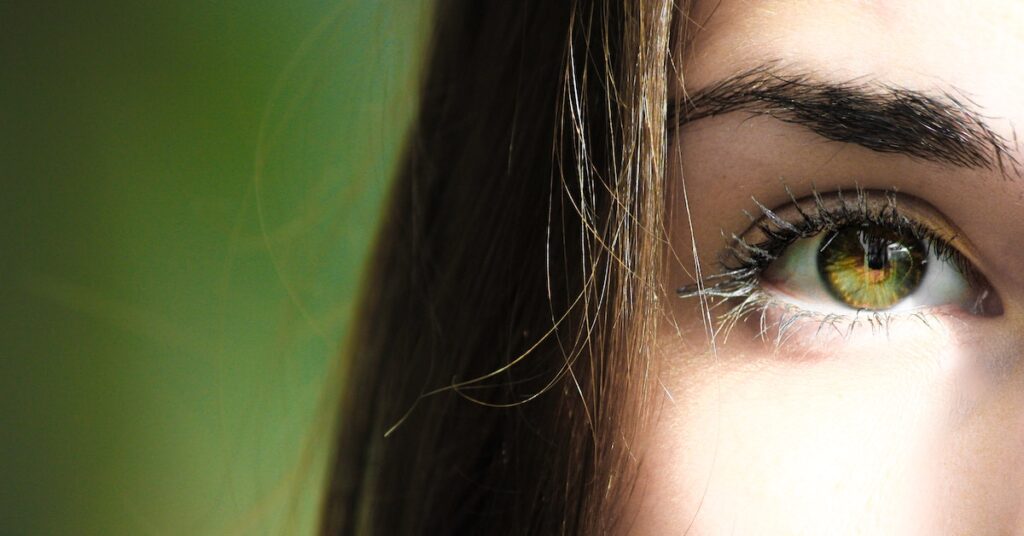What is the Near Point of Human Eye?

The ability to accept visual images and send them towards the brain makes human eyes a special kind of sense organ. It improves our vision of lighting, color, and depth as well as our capacity to see objects. These sensory systems also enable people to sense objects when external light enters them, working somewhat like cameras in that regard. Having said that, learning about the design and operation of the eye is extremely fascinating. It also helps us understand how a camera actually operates.
Near or close point of Human Eye:
The closest point to the eye in which an item can be positioned while still producing a sharp image on the retina is known as the close point of the eye. The close point of the eye, or punctum proximum, is the closest distance at which an item may be clearly viewed without effort. The near point is 25 cm away from the eye for a normal eye. The retina forms an image of the item that can be clearly interpreted when the item is positioned among 25 cm and infinity. A blurry picture is created behind the retina when an item is put closer than 25 cm, straining the eye.
The near point can occasionally change due to myopia and hypermetropia, two eye diseases, as well as we age.
| Age in years | Near point in cms |
| 11 | 7 |
| 20 | 10 |
| 31 | 14 |
| 42 | 25 |
| 50 | 50 |
| 60 | 100 |
In addition to having a close point of vision, humans also have a far point of vision:
The furthest point of the human eye is the furthest distance at which an item may be seen clearly. A typical person’s distant point is infinity. The term “far point” or “punctum remotum” refers to the distance from the eye where an item is best optimization on the retina when accommodation is fully relaxed. The furthest distance of the eye is the highest point where the eye can clearly view objects.
The static refract of the eye affects the far point of vision.
1) In an emmetropic eye, the near point fluctuates with age while the far end is at infinity.
2) The far end is virtual and is located behind the eye in a hyperopic eye.
3) It is genuine and appears in front of the myopic eye.
Range of Accommodation:
The ranging of accommodation is the separation between the close point and the distant point. The process through which certain muscles, referred to as ciliary muscles, operate to change the eyes’ focal distance so that the image is clearly formed on the retina is referred to as accommodation of the eye.
Purpose of accommodation of human eye:
The goal of accommodations of the eye is to change the focusing power and sharpen the focus of objects that are nearer to the eye by physiologically altering the crystalline lens components. Its goal is to adjust the lens’s refractive power so that it can focus on diverse objects automatically at different distances.
Amplitude of Accommodation:
The degree of accommodation required to shift the focus from a distant to a nearby place is known as the amplitude of accommodation (AA). From childhood until 65 years old, it gets smaller. It is the distinction between the eye’s refractive power when corrected for vision at a distance and when calibrated for vision at a close range.
Parts of Human Eye:
Human eye and brain collaborate in many different ways to aid with vision. The primary elements of your vision are as follows:
- Pupil: Your eye’s pupil, a little, black dot in the middle, serves as a window for light. In low light, it grows and in high light, it contracts. It is regulated by the iris.
- Cornea: The cornea is found at the eye’s surface. The dome-shaped cornea bends light as it enters your eye to perform its function.
- Iris: The pigmented tissue behind the cornea known as the iris gives the eye its color (blue eyes, for example) and regulates how much light enters the eye by modifying the size of the pupillary aperture. The anterior chamber and posterior chamber are separated by the mid (uveal) level of the eye’s middle layer.
- Lens: The eye’s built-in lens. Biconvex, transparent intraocular tissue aids in focusing light rays on the retina. suspended between ciliary processes by tiny ligaments called zoonules.
- Macula: The fovea-surrounded center region of the retina; a region of sharp central vision.
- Retina: It is a surface of many light-sensitive nerve cells. It transforms the lens’s generated pictures into electrical impulses. The brain then receives these electrical impulses through optic nerves.
- Sclera: The sclera is the outer layer, a strong, protecting white coating.
- Optic nerve: The nerve fibers from the photoreceptors make form the optic nerve. The optic disc is located behind the eye. There are two main types of photoreceptors – cones and rods. 1) Rods: Contrary to cones, rods do not provide fine Centre vision detail or sense color, while being both more frequent and significantly more light sensitivity than cones. 2) Cones: The macula, where cones are mostly concentrated, is where sharp, detailed Centre vision and color vision are produced.
- Fovea: The macula’s Centre spot, where vision is clearest, is called this. contains a lot of cones but no blood vessels in the retina.
Eye Muscles in Humans:
Extraocular muscles are the six muscles outside of the eyes that control all eye movement. The recti muscle and the oblique muscle are divided into two major categories. The medial, lateral, superior, and inferior recti muscles make comprise the recti muscles. The movement in the four cardinal directions—north, east, south, and west—is controlled by this muscle (or up, right, down, left). While the inferior and superior obliques, which are made up of two oblique muscles, are in charge of reversing head motions and regulating eye movements accordingly.
Both eyes may be moved and stabilized by the eye muscles. Each muscular pair (right and left) interacts with certain nerve Centre spread across brain and brainstem to coordinate precise eye movements with little conscious input. Each eye muscle has a resting muscular tone that is intended to maintain the posture of the eyes.
Lateral Rectus:
The lateral rectus muscle is located in the orbital of the eye. This muscle’s primary job is to move the pupil out from the body’s Centre. Latus, which means “side,” and rectus, which means “straight,” are the roots of the Latin term lateral rectus.
Inferior Rectus:
The inferior rectus originates of behind eye on the typical ring tendon and inserts at the front (front) region of the eye. Its main job is to depressing the eye, and its minor secondary jobs include extortion and adduction. The Latin name means “below,” and the term inferior is part of the name.
Medial Rectus:
The medial rectus originates of behind eye on the typical ring tendon and is another muscle of the eye’s orbit. To adduct the eye is its main purpose. The superior, medial, posterior aspect of the eye is where this muscle enters. Latin Medius, which means “middle,” is the root of the phrase medial rectus.
Superior Rectus:
The superior rectus muscle, which may be found near the top of the eye, is in charge of the eye’s upward movement. The oculomotor nerve regulates the superior rectus muscle’s movement. Latin influences can be found in the superior rectus. Rectus means “straight,” while superior means “above.”
Superior Oblique:
It is found on the upper medial side of the eye.7 bones that make up the eye socket, the sphenoid bone, is the source of the superior oblique eye muscle. This muscle controls intorsion, depression, and abduction in the neutral posture. This muscle has a fusiform look, which defines it. By preventing the eye from rotating unintentionally, it offers visual steadiness whether gazing up or down.
Inferior Oblique:
The front portion of the orbital floor, near the nose, is the source of the inferior oblique eye muscle. The inferior oblique muscle lifts the eye when it is oriented toward the nose, shifting the top of it far from the nose and pushing it upward. This muscle is in charge of extorsion, elevation, and abduction in the neutral posture.
Different eye shapes: The diverse shapes of the eyes and eyeballs make up the human eye’s appearance.
- Deep-set eyes: Because deep-set eyes are bigger and sit deeper in the skull, they draw the attention to the brow bone.
- Hooded-eye: These are characterized by extra soft tissue and skin covering the eyelid but not the actual eye. Because the skin above the eyelid develops a “hood” and leaves a noticeable furrow, the disorder is given that name.
- Upturned eyes: These eyes have higher outer corners than inner corners that curve upward. Upturned eyes, sometimes referred to as “cat eyes,” slant upwards, providing the eye an exotic aspect.
- Downturned eyes: With downturned eyes, you’re looking at the corner’s outer edge to check if it rises upward or downward. You may tell whether your eyes are downturned if the outer edge is pointing downward.
- Protruding eyes: These eyes have what appear to be eyelids that extend outward from the eye socket.
- Monolid eyes: These eyes have only one lid and little to no crease. They are flat on the outside.
- Close-set eyes: A person with close-set eyes has a limited space between their eyes.
- Wide-set eyes: Wide-set eyes are those in humans that have a definite distance between them.
Different Ocular or Eyeball Shapes:
1) Elongated eyeball:
Nearsightedness or myopia are other terms for an elongated eyeball. People with this syndrome have trouble perceiving distant objects.
2) Shortened eye:
Hyperopia, sometimes referred to as farsightedness, is characterized by a shortened eye. Having this situation makes it challenging to notice nearby items.
Healthy Human Eye’s Shape:
Light travels throughout the cornea and crystal lens of a healthy, properly formed eye and is best optimization onto the retina, which is situated behind the gel-filled eyeball. Through this procedure, an image can be sent to the optic nerve and afterwards to the brain’s visual cortex. The right form of each component of the eye is necessary for accurate focus and convergence.
How the Human Eye Functions:
The activities in the brain and eye when gazing at something happen very quickly. The cornea allows light to flow through while reflecting off things which, in the translucent region of the eye, completely covers the pupil and iris. The cornea will bend light rays so that they can pass through. Photoreceptors are unique cells found in the retina, it is a tissue layer near the back of the eyes. When light enters the retina, photoreceptors convert it into electrical impulses.
The optic nerve carries these electrical impulses first from retina then to the brain. The brain then processes the signal to produce the images you see.





